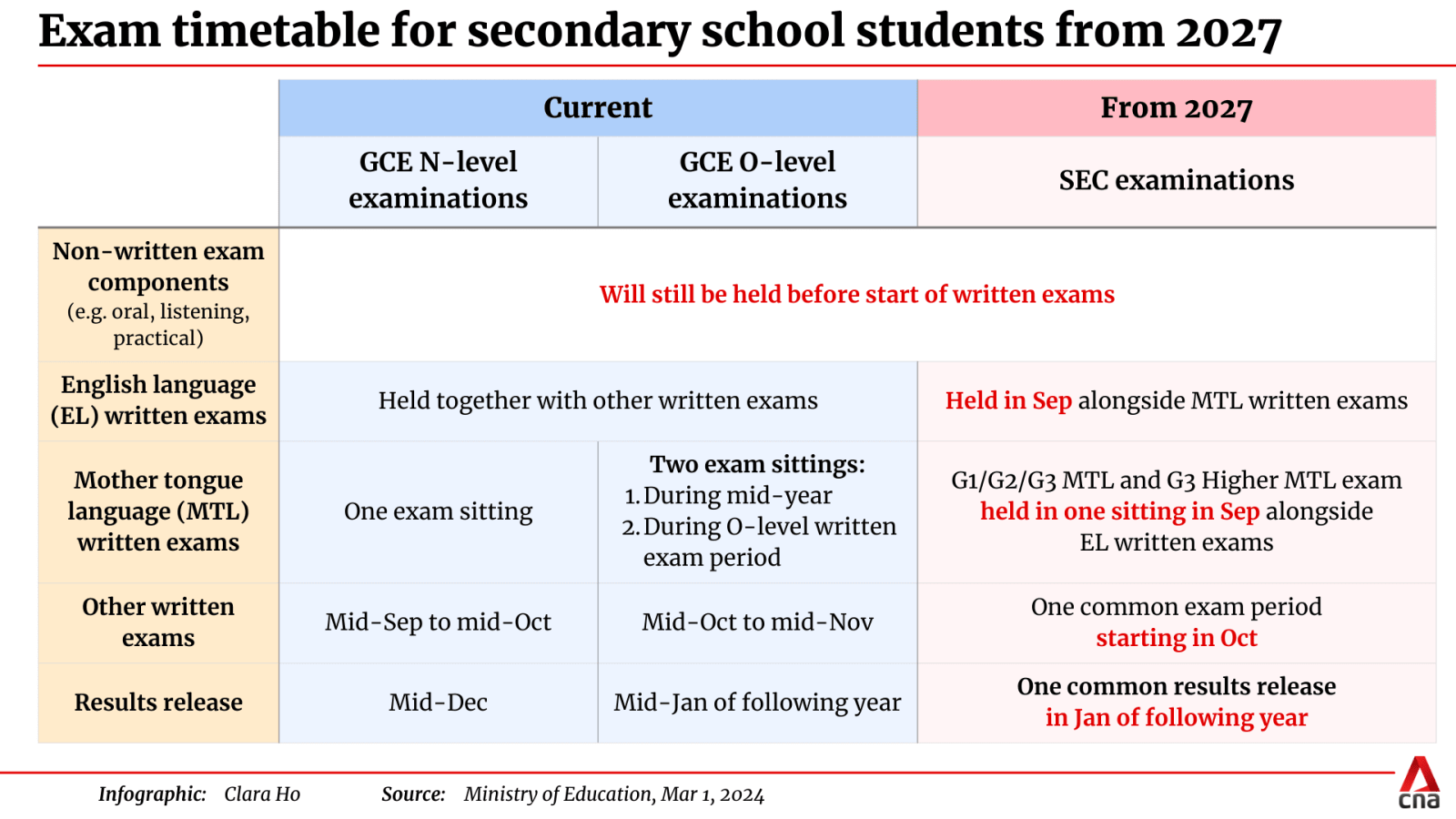Secondary 4 and 5 students to sit for English, mother tongue exams in September from 2027
Under the new Singapore-Cambridge Secondary Education Certificate, all students regardless of subject level will sit for their examinations in the same period.


This audio is generated by an AI tool.
SINGAPORE: From 2027, Secondary 4 and Secondary 5 students will sit for their final English and mother tongue examinations in September, and other subjects in October to November.
This means there will be just one sitting for the mother tongue exam instead of up to two sittings for current O-Level students, the Ministry of Education (MOE) said on Friday (Mar 1).
N-Level students now take their written exams, including mother tongue, in September to October. O-Level students currently take the mother tongue exams in mid-year and can opt to take them again with other papers in October to November.
Making the announcement in parliament on Friday, Education Minister Chan Chun Sing said that with the implementation of full subject-based banding, MOE is overcoming the challenges of reorganising classes and shuffling timetables to match the available resources.
“But the positive outcomes in learning and social mixing give us confidence that this is the right thing to do, notwithstanding the challenges.”
With the implementation of full subject-based banding this year, Secondary 4 students will take the new Singapore-Cambridge Secondary Education Certificate (SEC) from 2027. This replaces the N-Level and O-Level certifications.
Under subject-based banding, students now take subjects at a higher or lower level based on their strengths. These different subject levels are labelled G3, G2 and G1, mapped from the previous Express, Normal (Academic) and Normal (Technical) standards.
All Secondary 4 students, regardless of subject level, will have two common written exam periods for SEC – English and mother tongue in September, and other subjects starting in October.
Non-written exams such as oral, listening comprehension and practicals will continue to be held before the start of written exams.

Students will also receive their results at the same time, in January of the following year. Currently, N-Level students receive their results in mid-December while O-Level students receive their results in mid-January of the following year.
With these changes, the Institute of Technical Education (ITE) will only have one intake of students in April from 2027, aligning with the current intake for polytechnics. ITEs currently have two intakes in January and April.
Schools will have a few years to make the adjustments and prepare for this shift in exam timings, said MOE.
They will also be guided on how to pace the mother tongue curriculum to make use of the additional time.
DOUBLE-SITTING NO LONGER NEEDED AS "SAFETY NET": MOE
The mid-year sitting for mother tongue was introduced in 1980 when there were concerns that students might not clear the exam requirements for post-secondary education, the Education Ministry said.
At the time, less than 40 per cent of students passed both their first and second languages, said Mr Chan on Friday.
Now, about 97 per cent of O-Level candidates clear the mother tongue requirements. “The landscape is now so different that we don’t need to offer this as a safety net for our students. Almost all of them would have no trouble meeting the MTL (mother tongue language) requirement,” MOE said.
Over the years, a falling proportion of students are choosing to take the exam at the second sitting. In recent years, about one-third of the cohort took the second sitting, and less than 2 per cent of these students got a different posting outcome as a result.
With the mother tongue exams moved later in the year, schools will not have to rush to finish the syllabus before mid-year, said MOE.
As English and mother tongue language are not content-based subjects, students do not need a period for intensive revision just before the exams. Moving the papers earlier spaces out the overall examination load for students, the ministry added.
“I understand that some may be concerned that they will have one less chance to improve their MTL (mother tongue language) grades,” said Mr Chan.
“But we need to strike a careful balance between striving for excellence, chasing the last mark and allowing our students to learn at a better pace.”
ADJUSTING POLYTECHNIC ADMISSION CRITERIA
With subject-based banding, changes will also be made to the polytechnic year 1 admission criteria.
Students currently have to offer at least five O-Level, or G3, subjects, and achieve an aggregate score of 26 points or better. This score is based on English, two relevant subjects and two best subjects.
From 2028, one of their best subjects can be fulfilled at the G2 or G3 level, while the remaining subjects must be taken at the G3 level.
With these changes, the net aggregate cut-off score will also be adjusted from 26 points to 22 points.
















